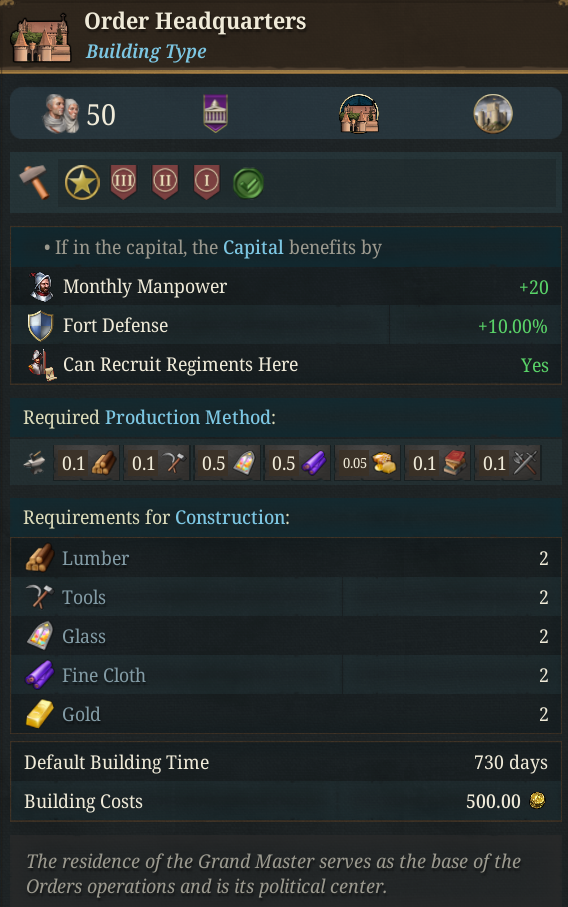Hello and welcome one more week to Tinto Flavour, the happy Fridays in which we take a look at the content of the super secret Project Caesar!
Today, we will be talking about the Christian Military Orders, and specifically, the Teutonic Order and the Knights Hospitallers! Let’s start without further ado:


As usual, consider all UI, 2D and 3D art WIP.
The Teutonic Order starts with an interesting political and diplomatic situation:


The Teutonic Order has several vassals, including the Livonian Order; but also starts at war with Poland and Lithuania - something that is not final, since we’re considering representing this Teutonic-Polish conflicts with a truce, instead, as it was resolved peacefully a few years after the start of our game.
While the situation of the Knights Hospitaller is also interesting, in a different way:

A Unique Location Minor with unique content spotted!
All Military Orders share some common flavour, starting with a Major Government Reform:

That unlocks some unique buildings:



The Order Headquarters is a capital-only building (so just one per country). The Order Stronghold is a building that you can build in any location you own. While the Order Commandery is a foreign building, that you can build in the lands of any Catholic country with which you have good relations, making it a powerful tool to support your crusading effort.
There’s also this Estate Privilege for your Clergy:

That unlocks a unique diplomatic action with other Catholic countries, the Sponsorship of Military Order:



As being theocracies, the Military Order also have access to unique Laws & Policies, such as:




Going to the more unique content for each, the Knights have access to a couple more reforms and privileges:


The Teutons start with another unique Estate Privilege, and a Work of Art:


And both have their own set of advances:
The Teutonic Order and the Knights also have a few dozen unique events each, but since today’s Tinto Flavour is already long enough, let’s just show one example per each:



And that’s all for today! Next Friday is a bank holiday in Tinto, so no Tinto Flavour; but remember that on Monday we will take a look at the Tinto Maps Feedback for Eastern, Central and Southern Africa, and on Wednesday there will be a Tinto Talks about Protestantism and the War of Religion. Cheers!
Today, we will be talking about the Christian Military Orders, and specifically, the Teutonic Order and the Knights Hospitallers! Let’s start without further ado:


As usual, consider all UI, 2D and 3D art WIP.
The Teutonic Order starts with an interesting political and diplomatic situation:


The Teutonic Order has several vassals, including the Livonian Order; but also starts at war with Poland and Lithuania - something that is not final, since we’re considering representing this Teutonic-Polish conflicts with a truce, instead, as it was resolved peacefully a few years after the start of our game.
While the situation of the Knights Hospitaller is also interesting, in a different way:

A Unique Location Minor with unique content spotted!
All Military Orders share some common flavour, starting with a Major Government Reform:

That unlocks some unique buildings:



The Order Headquarters is a capital-only building (so just one per country). The Order Stronghold is a building that you can build in any location you own. While the Order Commandery is a foreign building, that you can build in the lands of any Catholic country with which you have good relations, making it a powerful tool to support your crusading effort.
There’s also this Estate Privilege for your Clergy:

That unlocks a unique diplomatic action with other Catholic countries, the Sponsorship of Military Order:



As being theocracies, the Military Order also have access to unique Laws & Policies, such as:




Going to the more unique content for each, the Knights have access to a couple more reforms and privileges:


The Teutons start with another unique Estate Privilege, and a Work of Art:

And both have their own set of advances:
Teutonic Advances





Advances for the Knights Hospitallers










Advances for the Knights Hospitallers





The Teutonic Order and the Knights also have a few dozen unique events each, but since today’s Tinto Flavour is already long enough, let’s just show one example per each:



And that’s all for today! Next Friday is a bank holiday in Tinto, so no Tinto Flavour; but remember that on Monday we will take a look at the Tinto Maps Feedback for Eastern, Central and Southern Africa, and on Wednesday there will be a Tinto Talks about Protestantism and the War of Religion. Cheers!



